#webb discoveries
Text
Discovery Alert! In a new discovery released this week, The Intricate Dance of HD110067's Six-Planet Resonance Unveiled.
Discovery Alert! In a new discovery released this week, The Intricate Dance of HD110067's Six-Planet Resonance Unveiled. Read full article here

🌠 Brace yourselves for the cosmic marvel just revealed by the stars! 🌟 NASA's TESS and ESA's Cheops joined forces to unlock the secrets of HD110067, a star system with not 1, not 2, but SIX planets swirling in perfect cosmic choreography! 🪐✨
Picture this: a gravitational dance where six "sub-Neptunes" move in sync, painting the vastness of space with their rhythmic orbits. 🎶 It's like a mesmerizing ballet that's been unfolding for over a billion years! 🌌🎭
🔍 What's the scoop? TESS first detected the star's winks in 2020, hinting at potential planets. Fast forward to 2023, and Cheops steps in with its cosmic detective skills, revealing not just two, but a celestial sextuplet in perfect harmony. 🕵️♂️🔬
🔄 Orbital waltz alert! These planets are not just any space neighbors; they're in an "in sync" gravitational lockstep. Think of it as a rhythmic beat where each planet completes its cosmic loop with precision, creating a pattern that can literally be set to music! 🎵🌌
Let's give it up for the unsung heroes of the cosmic saga – the astronomers, the telescopes, and the satellites. 👏✨ The universe just dropped another beat, and we're here for it! 🚀💫 #CelestialDiscovery #CosmicSymphony #HD110067Dance #SpaceBallet #StellarHarmony
#CelestialDiscovery#CosmicSymphony#HD110067Dance#SpaceBallet#StellarHarmony#james webb space telescope#nasa#jwst#webb discoveries#esa
149 notes
·
View notes
Text
New James Webb Pictures!

New James Webb Pictures of Neptune!

This is the first time we’ve gotten a picture of Neptune’s rings - we’ve known they’re there for a while, and now we have pictures!
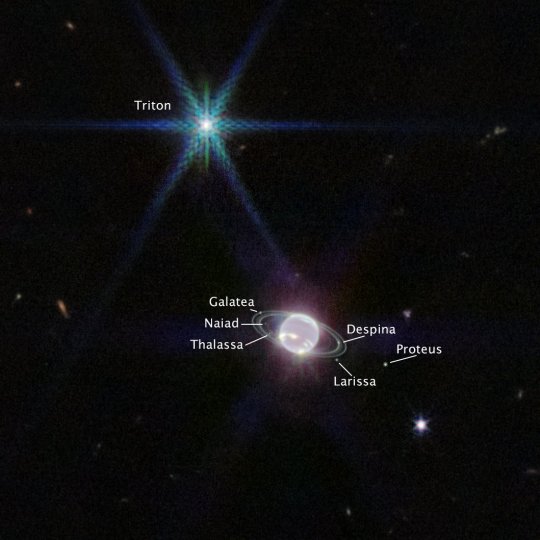
And here’s the visible moons labeled! (neptune has more moons than that)
#neptune#space#james webb#planets#triton#science#james webb telescope#space images#james webb images#discovery#ahhhh space fuck#its so pretttty#image posts#space pictures
3K notes
·
View notes
Text
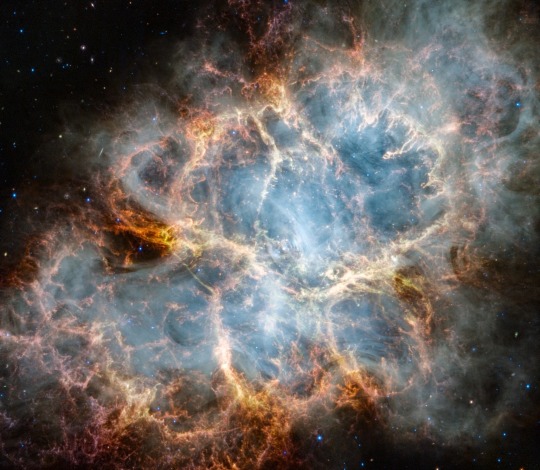
Crab Nebula, taken by the James Webb Space Telescope’s NIRCam (Near-Infrared Camera) & MIRI (Mid-Infrared Instrument)
Published by NASA 10/30/23
#photography#space#telescope#james webb space telescope#nebula#crab nebula#universe#stars#infrared#astronomy#galaxies#discovery#science#nasa
101 notes
·
View notes
Text








OC paintings so far! They are all based on something space related!
Left to Right:
James Webb (JWST), Trappist (TRAPPIST-1), Spitzer (SST), Chandra (CXO), Discovery (Space Shuttle), Habex (HabEx concept), Lynx (Lynx concept) and Luvoir (LUVOIR concept)
I have more ocs I plan to paint! Hubble and Origins are on the top of my list right now. Hope some of you might be interested to see them!
I also like talking about my ocs so if you want, you can ask me questions about them, or talk to me about anything space related because I love space!
#oc#original character#character design#character art#james webb#trappist#spitzer#chandra#space shuttle#discovery#habex#lynx#luvoir#my art#digital art#xenon art#space
80 notes
·
View notes
Text



Went on a cute little date with my better half yesterday ♥️ I love her so much ♥️
@weirdcreature28 ♥️
#we watched madame Webb#it was awesome!#she also bought me some clothes from discovery#I love her!#my babygirl
16 notes
·
View notes
Text
"Looking deep into space and time, two teams using the NASA/ESA/CSA James Webb Space Telescope have studied the exceptionally luminous galaxy GN-z11, which existed when our 13.8 billion-year-old universe was only about 430 million years old."
"The formation of the first stars and galaxies marks a fundamental shift in cosmic history, during which the universe evolved from a dark and relatively simple state into the highly structured and complex environment we see today."
continue reading article
#astronomy#space#universe#galaxies#primeval galaxy#history#evolution#stages of development#james webb telescope#james webb space telescope#webb telescope#science#technology#discovery
11 notes
·
View notes
Text
find the word
tagged by @squarebracket-trick, thank you! my words are trick, dead, before, and control
i am so close to being done with the first draft of claws, so lets pull from there. warnings for mentions of drug use,
no-pressure tagging @dogmomwrites @jmhwritesstuff and @andromedaexists with the words dive, flee, inevitable, and hunted.
trick(le)
Alice is high. She’s in the basement of Wonderland, sprawled out on a pile of black furs and red cushions, her eyes shining black and a thin trickle of blood running from her nose. Even through her thick white foundation, the dark veins on her face pulse visibly.
dead
(FIFTY ONE INSTANCES OF THIS APPARENTLY ASDKJS)
She lies there, twitching, her face not quite convinced she’s dead yet, mouth still trying to speak, eyes still trying to see him.
before
She didn’t leave before it all started. She was right in the middle of it and just never saw. Never bothered to look; not like Jaimie, who looked and saw and decided she was too busy being blind.
control
Calm down. Everyone’s always telling him that. Calm down, shut up, stop making a scene, you’re making us look bad, you’re embarassing us, why can’t you just CONTROL YOURSELF?
claws taglist: @belovedviolence @foxboyclit (ask to be +/-)
#writeblr#tag games#find the word#find the word tag#original fiction#snippets#wip#wip: claws#c: vivien webb#c: alice vox#god i have so much work to do on this draft#this is why i don’t usually discovery draft TT_TT
6 notes
·
View notes
Text

67 notes
·
View notes
Text
Rare Six-Planet Star System Discovery is Music to Astronomers’ Ears - Technology Org
New Post has been published on https://thedigitalinsider.com/rare-six-planet-star-system-discovery-is-music-to-astronomers-ears-technology-org/
Rare Six-Planet Star System Discovery is Music to Astronomers’ Ears - Technology Org
A rare star system with six exoplanets has been discovered with an architecture unchanged for billions of years.
Exoplanet – illustrative photo. Image credit: Pixabay (Free Pixabay license)
The star, HD110067, that is 100 light-years away in the northern constellation of Coma Berenices, has been perplexing researchers for years. Now scientists, including those at the University of Warwick, have revealed the true architecture of this unusual system using NASA and ESA spacecrafts.
The first indication of planets orbiting the strange star system came in 2020, when NASA’s Transiting Exoplanet Survey Satellite (TESS) detected dips in the star’s brightness that suggested planets were passing in between the star and the TESS spacecraft. A preliminary analysis revealed two possible planets. One with a year (or an orbital period – the time it takes to complete one orbit around the star) of 5.64 days and another with an unknown period at the time.
Two years later, TESS observed the same star again. Analysing all data ruled out the original interpretation but presented two additional possible planets, changing the picture of the planetary system completely.
youtube
Much was still unknown about the planetary system, and that was when Rafael Luque of the University of Chicago and scientists across the world – including those at the University of Warwick – joined the investigation. They used data from the European Space Agency’s (ESA) CHaracterising ExOPlanet Satellite (CHEOPS), hoping to determine the orbital periods of these faraway planets.
The CHEOPS data was key in confirming a third planet in the system and the team had found the key to unlocking the whole system. It was now clear that the three planets were in a pattern of orbits known as an ‘orbital resonance’. For example, an outer planet takes 20.52 days to orbit, which is extremely close to 1.5 times the orbital period of the next planet with 13.67 days. This in turn is almost exactly 1.5 times the orbital period of the inner planet, with 9.11 days.
Thomas Wilson, Department of Physics, University of Warwick, said: “By establishing this pattern of planet orbits, we were able to predict other orbits of planets we hadn’t yet detected. From this we lined up previously unexplained dips in starlight observed by CHEOPS and discovered three additional planets with longer orbits. This was only possible with the crucial CHEOPS data.”
Orbitally resonant systems are extremely important to find because they tell astronomers about the formation and subsequent evolution of the planetary system. Planets around stars tend to form in resonance but can easily have their orbits thrown around.
For example, a very massive planet, a close encounter with a passing star, or a giant impact event can all disrupt the careful balance. As a result, many of the multi-planet systems known to astronomers are not in resonance meaning that multi-planet systems preserving their resonance are rare.
“We think only about one percent of all systems stay in resonance,” explains Rafael Luque. That why HD110067 is special and invites further study. “It shows us the pristine configuration of a planetary system that has survived untouched.”
“As our science team puts it: CHEOPS is making outstanding discoveries sound ordinary. Out of only three known six-planet resonant systems, this is now the second one found by CHEOPS, and in only three years of operations,” says Maximilian Günther, ESA project scientist for CHEOPS.
HD110067 is the brightest known system with four or more planets. Since those planets are all sub-Neptune-sized with likely larger atmospheres, it makes them ideal candidates for studying the composition of their atmospheres using the NASA/ESA/CSA James Webb Space Telescope and the ESA’s future Ariel telescope. Whereas ESA’s upcoming PLATO telescope, due to be launched in 2026, within which the University of Warwick is playing a leading role, could find planets in this system with even longer years.
Thomas Wilson added: “All of these planets have large atmospheres – similar to Uranus or Neptune – which makes them perfect for observation with JWST. It would be fascinating to test if these planets are rocky like Earth or Venus but with larger atmospheres – solid surfaces potentially with water. However, they are all much hotter than Earth, 170-530 degrees Celsius, which would make it very difficult for life to exist.”
“A resonant sextuplet of sub-Neptunes transiting the bright star HD 110067” by R. Luque et al. is published in Nature today. DOI 10.1038/s41586-023-06692-3
Source: University of Warwick
You can offer your link to a page which is relevant to the topic of this post.
#Analysis#architecture#Astronomy news#coma#Coma Berenices#Composition#data#Discoveries#ears#earth#ESA#European Space Agency#Evolution#exoplanet#Exoplanets#Featured Space news#form#Future#it#James Webb Space Telescope#jwst#life#Light#Link#Music#NASA#nature#One#orbit#Other
3 notes
·
View notes
Text
NASA's Webb Telescope discovers "mini-Neptune" planet GJ 1214 b
Exciting news! NASA's Webb Telescope has discovered a "mini-Neptune" planet outside our solar system. Learn more about GJ 1214 b! #NASA #GJ1214b #MiniNeptune
NASA’s James Webb Space Telescope has made an exciting discovery – the closest look yet at a mysterious, “mini-Neptune” planet outside our solar system. The planet, called GJ 1214 b, has a steamy atmosphere and is highly reflective, making it difficult to see through conventional observation methods. However, the Webb telescope’s Mid-Infrared Instrument (MIRI) was able to capture a “heat map” of…
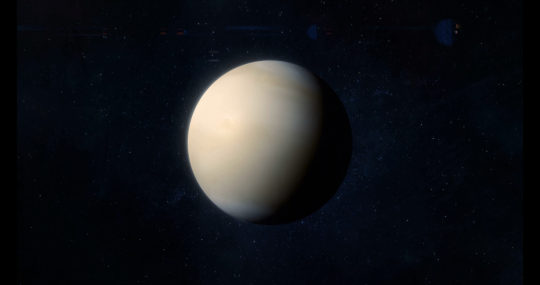
View On WordPress
#discoveries#Exoplanet#GJ 1214 b#heat map#James Webb Space Telescope#Mini-Neptune#NASA#science#space exploration#water world
2 notes
·
View notes
Text
In a new discovery released on August 21, 2023, James Webb Telescope captures remarkable images of the iconic Ring Nebula.
Read full article here
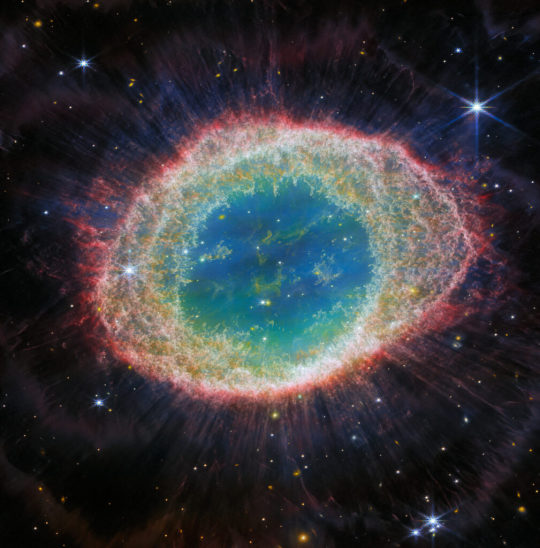
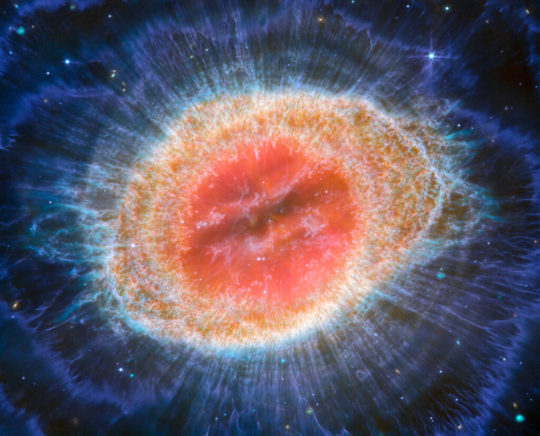
254 notes
·
View notes
Text
smaller
the wwweb brought new perspective
the entire world suddenly reduced to a keystroke's distance from my hand
the world became more connected through this box
this virtual exploration
the world becomes smaller, and so too does my place in it
the Webb brought new perspective
universal expansion exploded and the scope made clear how minuscule my sand really is
my sense of self becoming more disconnected through this box
this universal explorer
the world becomes smaller, and so too does my place in it
I shrink from the weight of its scale
and the utter lack of my own
once believed myself a stone
now I see that I am just a fleeting reflection of the shadows cast by the clasts
the grains of the sands I believed I could weather
that I somehow out measured
the pompous presumptions of grandeur and meaning
my life has been a series of reductive discoveries and advances towards meaninglessness
and yet...I persist
I stand on these sands striking at the ground hoping to leave marks that will prove somehow indelible
unintelligible and microscopic when measured against the grand scheme
and yet...still I dream
I kept looking for meaning outside of myself,
when in truth, meaning comes from the inside, it comes from us
that which we create and put out into the sands
it's the only meaning that can mean anything in this vastness
if each of our moments are rendered insignificant against the scale
then each of those moments are significant and only have meaning when measured against ourselves and our own experiences for that is what shapes them and gives them context
a context intrinsically imbued with meaning
understand the vastness, yes
but do not try to see ourselves in relation to that enormity, for that is not the scale of import
the scale of difference
for our impact is smaller, and must be understood as such
for we are part of an ecosystem...delicate and demanding
and it is there our meaning adds balance
that our difference is made and is measurable
here, we are the grains, and it is our actions that weather this stone
that shape it
give it texture
I became smaller, but the fact that I am here at all...looms still so large
more improbable
more impossible
and all the more meaningful and amazing because of it
(8/18/22)
#poetry#introspective articulations#twenty years a poet#www#webb telescope#discovery#advancements#scale#scope#humanity#from stones to sands to shadows#insignificant#depression#still we matter
3 notes
·
View notes
Text

👤My 'Moon' journey through 'MidJourney' AI 🤖 AI in architecture📐- Lunar exploration🌕
🧰Tools: Creativity🧑🎨+ MidJourney AI🤖+ Photoshop🧑💻+ Nasa - Cosmic Cliffs Image
#architecture#archidaily#moodboard#outer space#full moon#architecturefactor#architect#aiart#dalle2#aiinarchitecture#architecturestudent#lunar#metaverse#nasa james webb telescope early projects jwst space discovery history james webb
3 notes
·
View notes
Photo



(via JWST- James Webb Space Telescope Bucket Hat by DjoooDjooo)
#findyourthing#redbubble#jwst#nasa james webb telescope early projects jwst space discovery history james webb#james webb space telescope
1 note
·
View note
Link
Prepare to journey through the cosmos with host Anna on today's episode of Astronomy Daily - The Podcast. We delve into a treasure trove of astronomical breakthroughs, from the discovery of ancient stardust that defies our solar system's norms to the pioneering hunt for dark matter. We'll explore the origins of a supernova-born dust particle that challenges our astrophysical understanding and Yale University's innovative quest to capture the elusive axions that could unlock the mysteries of the universe's mass.
Then, witness the dawn of Europe's Ariane 6 rocket as it stands poised for its maiden voyage, symbolizing a leap forward in Europe's space aspirations. But it's not all smooth sailing; the Hubble Space Telescope faces a gyroscope challenge, testing NASA's resolve and ingenuity. We'll discuss the implications of this temporary setback and the anticipation of Hubble's return to its celestial watch.
The episode continues with the James Webb Space Telescope's surprising revelation of early galaxies' maturity, a finding that rewrites our narrative of cosmic evolution. Finally, we track the return of NASA's Dragon spacecraft, a beacon of scientific discovery, as it brings home invaluable research from the International Space Station.
Join us on this interstellar odyssey as we unpack these cosmic stories and ponder the ever-expanding frontiers of space exploration. This is Astronomy Daily - The Podcast, where every episode is a revelation of the universe's endless marvels.
---
**Featured Topics:**
1. **Ancient Stardust Mystery:** Unveiling the supernova origins of a meteorite's dust particle with unprecedented magnesium isotopic ratios.
2. **Dark Matter's New Hope:** Yale's axion detection experiment and the metamaterials revolutionizing our cosmic search.
3. **Ariane 6's Inaugural Campaign:** Europe's monumental step towards sovereign space exploration.
4. **Hubble's Gyroscope Woes:** Navigating the challenges of space technology and the resilience of NASA's iconic telescope.
5. **James Webb's Galactic Insights:** The unexpected early maturity of ancient galaxies and the rethinking of universal history.
6. **Dragon's Scientific Bounty:** NASA's spacecraft returns with a cache of knowledge from the orbital frontier.
---
**Additional Information:**
For more cosmic content, visit astronomydaily.io, and stay connected with us on X (@AstroDailypod) for the latest updates and stellar news. Until next time, this is Anna, reminding you to keep your eyes on the skies and your mind on the wonders above. Clear skies and boundless curiosity to all our fellow stargazers!
This episode is brought to you by NordPass, the password manager that secures your celestial data. To grab our special offer and find out more, visit www.bitesz.com/nordpass
Become a supporter of this podcast: https://www.spreaker.com/podcast/astronomy-daily-the-podcast--5648921/support
#space #astronomy #news #podcast #thestorieswetold
#ancient#ariane#astronomical#dark#discoveries#dragon#hubble#hunt#james#matter#nasa#remnants#rocket#six#space#spacecraft#stardust#supernova#telescope#webb
0 notes
Text
Webb reveals new structures within iconic supernova

(Credit: Science: NASA, ESA, CSA, M. Matsuura (Cardiff University), R. Arendt (NASA-GSFC, UMBC), C. Fransson (Stockholm University), J. Larsson (KTH). Image Processing: A. Pagan (STScI).)
"NASA's James Webb Space Telescope has begun the study of one of the most renowned supernovae, SN 1987A (Supernova 1987A). Located 168,000 light-years away in the Large Magellanic Cloud, SN 1987A has been a target of intense observations at wavelengths ranging from gamma rays to radio for nearly 40 years, since its discovery in February of 1987. New observations by Webb's NIRCam (Near-Infrared Camera) provide a crucial clue to our understanding of how a supernova develops over time to shape its remnant.
This image reveals a central structure like a keyhole. This center is packed with clumpy gas and dust ejected by the supernova explosion. The dust is so dense that even near-infrared light that Webb detects can't penetrate it, shaping the dark "hole" in the keyhole.
A bright, equatorial ring surrounds the inner keyhole, forming a band around the waist that connects two faint arms of hourglass-shaped outer rings. The equatorial ring, formed from material ejected tens of thousands of years before the supernova explosion, contains bright hot spots, which appeared as the supernova's shock wave hit the ring. Now spots are found even exterior to the ring, with diffuse emission surrounding it. These are the locations of supernova shocks hitting more exterior material."
continue reading article
#cosmology#james webb space telescope#james webb telescope#JWST#astronomy#space#universe#science#discovery#star#wavelength#visible spectrum#waves#electromagnetism#hourglass#magnetic field
4 notes
·
View notes